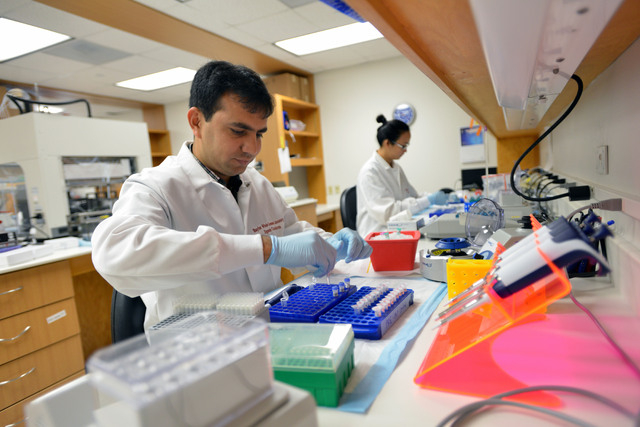Gene scans solve mystery diseases in kids, adults


They were mystery diseases that had stumped doctors for years — adults with strange symptoms and children with neurological problems, mental slowness or muscles too weak to let them stand. Now scientists say they were able to crack a quarter of these cases by decoding the patients’ genes.
Their study is the first large-scale effort to move gene sequencing out of the lab and into ordinary medical care, and it shows that high hopes for this technology are finally paying off.
“This is a direct benefit of the Human Genome Project,” the big effort to decode our DNA, said Dr. Christine M. Eng of Baylor College of Medicine in Houston. “We’re now able to directly benefit patients through more accurate diagnosis.”
She led the study, which was published online Wednesday by the New England Journal of Medicine. It gives results on the first 250 patients referred to Baylor for a newer type of sequencing — just the DNA segments that hold the recipes for all the proteins the body needs. That’s only about 1 percent of the whole genome.
Baylor has sequenced more patients beyond those in the study — 1,700 so far — and found gene flaws in 1 out of 4, Eng said.
That rate will improve as more genes are linked to diseases, but it’s already much higher than the less comprehensive gene tests done now, said Rebecca Nagy, a scientist at Ohio State University and president of the National Society of Genetic Counselors.
“For some of these conditions there could be treatments that are lifesaving,” she said.
Already, three people tested at Baylor were found to have a muscle disorder that can cause respiratory problems and even death. The condition is aggravated by infections and stress, and there are drugs to treat those and prevent serious episodes, Eng said.
In other cases, having a diagnosis helped parents like Lindsey and Brandon Collier decide whether to have more children. The Colliers, who live in Georgetown, Texas, about 30 miles north of Austin, searched for years for an answer to what was plaguing their son, Cannon, now 4.
“He was a pretty floppy baby” with poor muscle tone and problems eating, Lindsey Collier said. “We weren’t getting any answers and they were just all over the map on everything they were testing for.”
“It is a huge weight lifted off our shoulders” she said of testing at Baylor that found a rare muscle disorder.
Genetic counselors said the problem was not likely to occur in other offspring, so the Colliers had a second child. Their 6-week-old daughter, Smith, is fine, and Cannon is being helped now by intensive physical therapy and other treatments.
Just having a diagnosis is very valuable because it ends the expensive and emotionally exhausting testing that parents go through, said Dr. Robert C. Green, a geneticist at Brigham and Women’s Hospital and Harvard Medical School.
“Many of these are children or adults that have had a mystery illness for many years. Their families don’t know what it is and they’re sort of desperate for an answer,” and it’s not possible to find a treatment until you find the cause, he said.
In the study of the first 250 patients at Baylor, 62 were found to have gene flaws. In 33 cases, only one faulty copy of a gene was responsible. In 16 other cases, both copies of a gene were bad. Four patients had problems in two different genes. Nine patients had faulty genes on the X chromosome. Since boys have only one copy of that sex chromosome, those disorders mostly affect that gender.
Baylor gets revenue from gene testing, and two study leaders are consultants or paid speakers for gene testing companies not involved in the study. The government’s National Human Genome Research Institute helped pay for the study, and insurers covered much of the testing. It cost $7,000 per case, which usually included sequencing the parents’ genes.
The price will drop and the usefulness will rise over time, Dr. Howard Jacob of the Medical College of Wisconsin wrote in an editorial in the journal. Several years ago, he sequenced the genes of a 5-year-old Wisconsin boy who suffered from a rare genetic disease. That unprecedented feat led to a cord blood transplant and other treatments for the boy.
Other areas of medicine are exploring gene sequencing. Last month, the government launched a pilot project to try it for newborn screening. In December, two studies reported on its use to screen embryos during fertility treatments, and for figuring out the cause of stillbirths.
———
Online:
Journal: http://www.nejm.org
———
Marilynn Marchione can be followed at http://twitter.com/MMarchioneAP












